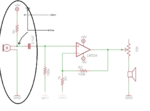preethi19
Full Member level 5
Hi i was learning about RC filter and i came across a circuit. I have attached the image below.

The video wer i found this image is in "Passive RC high pass filter tutorial!" in youtube.
I have circled the part of the circuit wer my doubt is. The 9V supply is used for powering the microphone. So they have arrow marked the node which has a peak to peak signal of 20mV with a DC offset of 9V which comes from the supply. I understand that the supply adds up as an offset with the 20mV signal from the microphone. My doubt is der is a series resistor from the 9V supply. Isnt the voltage supposed to drop down??? I thought a resistor in series connection lets the same current to pass through but causes a voltage drop. Can someone pls clear this for me.. Thank you!!!

The video wer i found this image is in "Passive RC high pass filter tutorial!" in youtube.
I have circled the part of the circuit wer my doubt is. The 9V supply is used for powering the microphone. So they have arrow marked the node which has a peak to peak signal of 20mV with a DC offset of 9V which comes from the supply. I understand that the supply adds up as an offset with the 20mV signal from the microphone. My doubt is der is a series resistor from the 9V supply. Isnt the voltage supposed to drop down??? I thought a resistor in series connection lets the same current to pass through but causes a voltage drop. Can someone pls clear this for me.. Thank you!!!